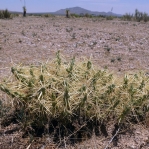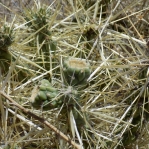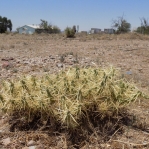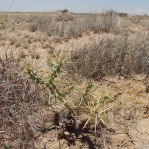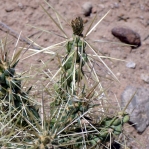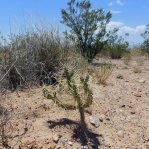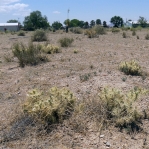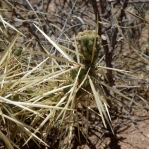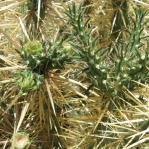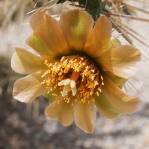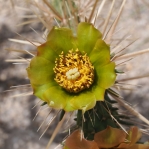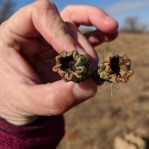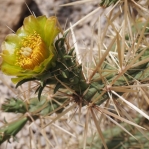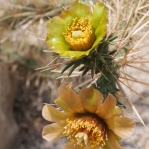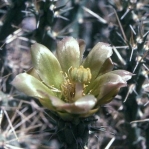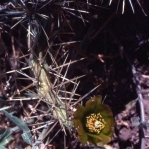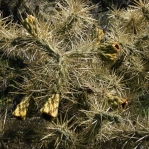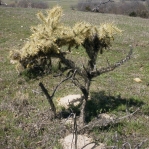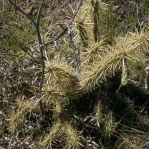Engelmann & J. M. Bigelow. 1856. Proceedings of the American Academy of Arts and Sciences 3: 305.
Herbarium specimen; Herbarium specimen; Herbarium specimen; Herbarium specimen; Drawing (Curtis’s Botanical Magazine, 1882); Drawing (Plates to the Cactaceae of Whipple’s Expedition, 1856)
Original description
Flora of North America treatment
What is Cylindropuntia davisii?
Cylindropuntia davisii is a cholla found in sandy to loamy soils of grasslands, oak-juniper-mesquite woodlands, plains, and slopes of eastern New Mexico and western Texas (rarely central) from approximately 600 to 1500 m elevation.
Details
G. davisii plants are densely branched shrubs to 0.6 m tall, with easily detached terminal stem segments. The stems are 4 to 6 cm long by 0.8 to 1.2 cm wide with 7 to 21 yellow to nearly black spines that obscure the stems. The sheaths are loose and yellow. Flowers are yellow-green, tinged purple-red and age to red-brown. Filaments are pale green at the base to purple-tinged distally, with orange-yellow anthers. The styles are cream to pale green, sometimes faintly pinkish-purple distally, with very pale green stigmas lobes. The fruits are yellow, pulpy, and spineless, often in chains of two. Cylindropuntia davisii is diploid (2n = 22) and tetraploid (2n = 44).
Curtis’s Botanical Magazine wrote in 1882 that O. davisii is: “A small shrubby species, remarkable for the bronzy color of the flowers, which have a peculiar metallic lustre…G. davisii is a native of the district of New Mexico, eastward and westward of the Tucumcari Hills…on the head waters of the Canadian River, a branch of the Arkansas.” Britton and Rose reported that the plant was confused with other Cylindropuntia species for years.
Dave Ferguson writes:
Cylindropuntia davisii is a species that is known as apparently only two clones that reproduce vegetatively. The more widespread yellow-spined clone is found on the Great Plains from southwest Oklahoma, the Texas Panhandle, and northeast New Mexico, southward apparently to near the Balcones Escarpment in western Texas and across central and southwest New Mexico into northwest Chihuahua (mostly in isolated colonies). It is found in grasslands on sandy (often straight sand) soils.
The red-brown clone is found apparently only in grasslands south of the Davis Mountains in Texas (Jeff Davis, Brewster, and Presidio Counties), and perhaps into Chihuahua. It too favors sandy soils in grassland.
I’ve personally never seen seeds on that clone either. Apparently the Great Plains clone is tetraploid (2n = 44), whereas the Trans-Pecos clone is diploid (2n = 22). I’ve never tried to get the two together to see if they will make seeds if cross-pollinated. A good place to see the Trans-Pecos clone (if our memory is correct) is the Fort Davis cemetery.”
